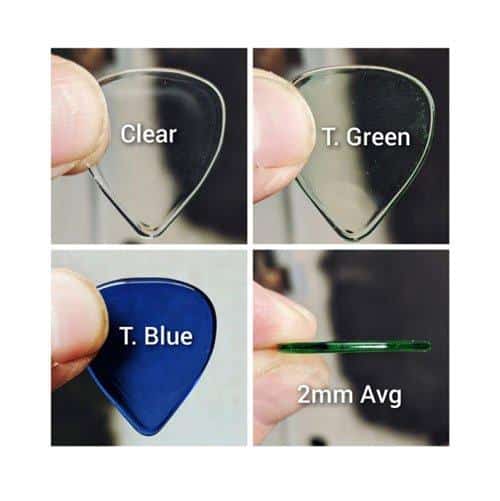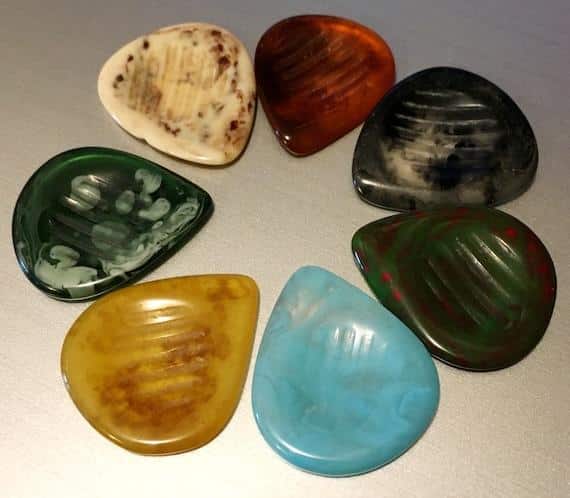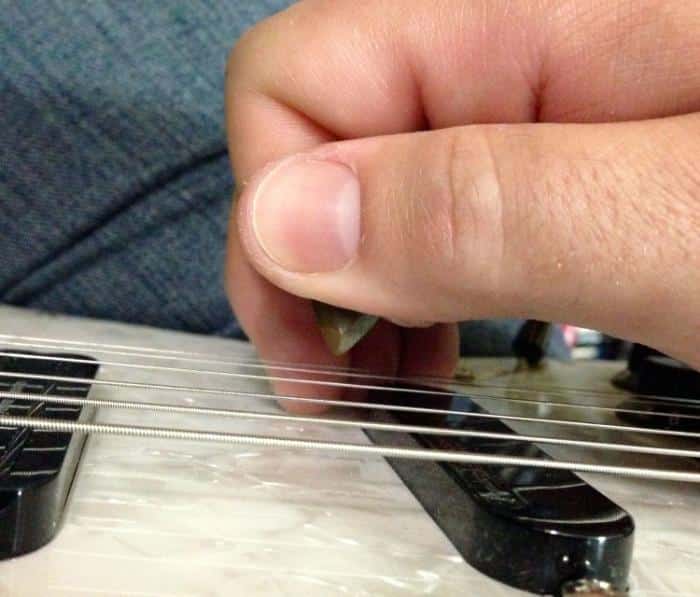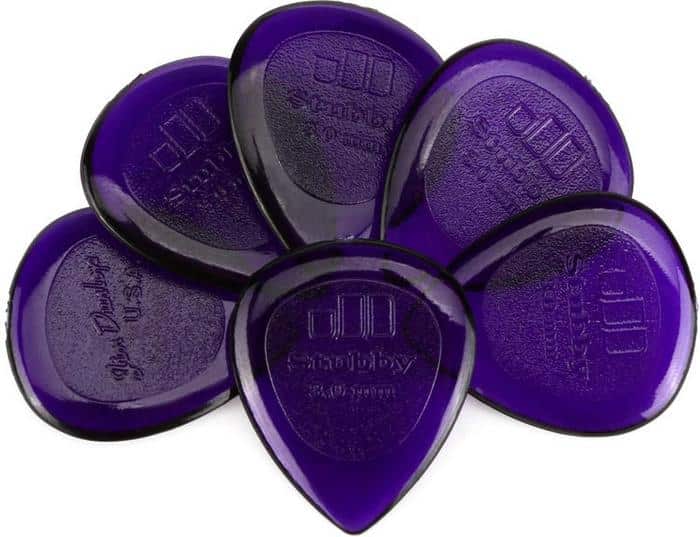The moment I switched to a jazz-specific guitar pick, my entire musical world transformed. It was like discovering a hidden superpower I never knew I possessed. Suddenly, my notes had more clarity, my chord transitions became smoother, and my solos took on a new life. But here’s the kicker: I had no idea which pick was truly the best for my style. That’s when my obsession with jazz guitar picks began.
As a jazz guitarist and educator, I’ve spent countless hours exploring the nuances of guitar picks. My journey began during my studies at the New England Conservatory, where I discovered how profoundly a pick could influence my sound. This guide is a culmination of years of experimentation and the wisdom I’ve gained from interviewing legendary jazz guitarists for ‘Acoustic Guitar’ magazine. Join me as we dive into the world of best jazz picks, and let’s find the perfect plectrum to elevate your jazz guitar playing to new heights.
Top-Rated Jazz Guitar Picks
| Product | Material | Thickness | Shape | Grip | Tone | Durability | Price Range |
|---|---|---|---|---|---|---|---|
| Dunlop Jazz III | Nylon | 1.38mm | Small, pointed | Excellent | Bright, articulate | High | $ |
| Fender 351 Premium Celluloid Jazz Picks | Celluloid | 0.46mm – 1.21mm | Traditional 351 | Good | Warm, vintage | Medium | $ |
| D’Addario Black Ice Guitar Picks | Duralin | 0.50mm – 1.50mm | Standard | Very good | Balanced, crisp | High | $$ |
| Clayton Ultem Jazz Picks | Ultem | 0.38mm – 1.52mm | Teardrop | Good | Clear, focused | Very high | $$ |
| Gravity Picks Jazz Master | Acrylic | 1.5mm – 3.0mm | Jazz XL | Excellent | Full, rich | Very high | $$$ |
Dunlop Jazz III
Best for precision and speed

As a jazz guitarist and educator, I’ve experimented with countless picks over the years, but the Dunlop Jazz III remains my ultimate choice. Its sharp tip and small size offer unparalleled precision and speed, essential for intricate jazz phrases. I vividly recall using it during a challenging Jim Hall transcription for my book, where its crisp attack and controlled release made complex passages sing.
The Jazz III’s stiff nylon construction provides excellent durability and a bright, articulate tone that cuts through any mix. Its compact profile allows for effortless string skipping and hybrid picking techniques, crucial for modern jazz styles. While some players might find it too small initially, I’ve found that the learning curve is well worth the improved control and articulation.
Compared to the Fender 351 Premium Celluloid, the Jazz III offers superior precision but sacrifices some of the warm, vintage tone celluloid provides. The D’Addario Black Ice, while similar in shape, doesn’t quite match the Jazz III’s iconic feel and responsiveness that has made it a staple among jazz virtuosos.
Pros:
- Exceptional precision and speed
- Durable nylon construction
- Bright, articulate tone
- Ideal for complex jazz techniques
Cons:
- Small size may require adjustment period
- Less warm tone compared to celluloid picks
Fender 351 Premium Celluloid Jazz Picks
Best for warm, vintage tone

Best for warm, vintage tone
As a jazz guitarist and educator, I’ve experimented with countless high-quality jazz picks over the years. The Fender 351 Premium Celluloid Jazz Picks hold a special place in my heart and my gig bag. These guitar plectrums for jazz transport me back to my formative years at the New England Conservatory, where I spent countless nights honing my craft.
The warm, mellow tone these picks produce is quintessentially jazz. During a recent workshop, I handed one to a struggling student, and the transformation in his sound was immediate. The vintage feel and smooth attack allowed him to effortlessly glide through complex chord progressions, bringing a newfound richness to his playing.
While the Dunlop Jazz III offers precision for fast runs, and the D’Addario Black Ice provides a brighter attack, the Fender 351 strikes a perfect balance between comfort and tonal warmth. It’s my go-to recommendation for students seeking that classic jazz guitar sound.
Pros:
- Produces warm, vintage tone ideal for jazz
- Comfortable shape for extended playing sessions
- Durable celluloid material
Cons:
- May be too thick for some players
- Limited color options
D’Addario Black Ice Guitar Picks
Best for enhanced grip and control

Best for enhanced grip and control
As a seasoned jazz guitarist, I’ve tried countless picks, but the D’Addario Black Ice Guitar Picks have truly revolutionized my playing. I first encountered these gems while reviewing gear for Premier Guitar, and they’ve since become an indispensable part of my arsenal, especially for those high-pressure gigs.
The textured grip on these picks is a game-changer. I vividly recall a sweltering outdoor performance in Culver City where my usual picks kept slipping. Switching to the Black Ice mid-set was like finding an oasis in the desert. The enhanced control allowed me to navigate complex chord progressions and intricate solos with newfound confidence.
What sets these picks apart for jazz tone is their unique blend of durability and flexibility. They offer a crisp attack while maintaining enough give for those warm, mellow passages essential to jazz. The beveled edge facilitates smooth picking across strings, perfect for fast runs and arpeggios.
Compared to the Dunlop Jazz III, the Black Ice offers a slightly larger profile, which some players might prefer. While the Jazz III excels in speed, the Black Ice provides a more balanced approach, suitable for a wider range of jazz styles. The Clayton Ultem Jazz Picks offer similar durability but lack the textured grip that makes the Black Ice stand out.
Pros:
- Exceptional textured grip for superior control
- Versatile tone suitable for various jazz styles
- Durable yet flexible material
Cons:
- Slightly pricier than some alternatives
- May take time to adjust for players used to smaller picks
Clayton Ultem Jazz Picks
Best for bright, articulate sound

When it comes to best plectrums for jazz, Clayton Ultem Jazz Picks have become my go-to choice for achieving a bright, articulate jazz guitar sound. During the development of my ‘Color Your Chords’ book, these picks were instrumental in helping me demonstrate the intricacies of complex jazz chord voicings. Their exceptional clarity allowed me to showcase the nuances of note definition, a crucial aspect of jazz playing that I often emphasize to my students.
I vividly recall a masterclass where I was teaching a particularly challenging passage. As I switched to the Clayton Ultem, the difference was immediately noticeable. The pick’s precision brought each note to life, allowing the students to hear every subtle harmonic detail. It was a pivotal moment that underscored the importance of pick selection in achieving the desired tonal qualities.
While the Clayton Ultem excels in brightness and articulation, it’s worth noting how it compares to other top contenders. The Dunlop Jazz III, for instance, offers a warmer tone and faster attack, making it ideal for rapid single-note runs. In contrast, the Fender 351 Premium Celluloid provides a more vintage feel and rounder tone, perfect for traditional jazz styles. The Clayton Ultem strikes a balance, offering modern precision with enough warmth to suit various jazz subgenres.
Pros:
- Exceptional brightness and articulation
- Perfect for demonstrating complex chord voicings
- Durable material maintains consistency over time
Cons:
- May be too bright for some traditional jazz styles
- Slightly higher price point compared to some alternatives
Gravity Picks Jazz Master
Best for customizable thickness

Best for customizable thickness
As a jazz guitarist and former freelance transcriber, I’ve found the Gravity Picks Jazz Master to be a game-changer in the world of recommended jazz guitar picks. The standout feature is its customizable thickness, allowing me to fine-tune my tone for different jazz styles. During a recent recording session, I switched between a thinner pick for delicate chord work and a thicker one for punchy single-note lines, all without changing brands.
The Jazz Master’s precision and clarity are unparalleled, especially when compared to the Dunlop Jazz III. While the Jazz III offers excellent control, the Gravity Pick’s customizable nature gives it an edge in versatility. Unlike the Fender 351 Premium Celluloid, which has a fixed thickness, the Jazz Master adapts to your playing style, making it ideal for jazz guitarists who frequently switch between rhythm and lead roles.
The pick’s beveled edge provides a smooth attack, essential for those flowing jazz lines. However, the premium quality comes at a higher price point, which might deter some players. Despite this, for serious jazz guitarists seeking the perfect plectrum, the Gravity Picks Jazz Master is well worth the investment.
Pros:
- Customizable thickness for versatile tone shaping
- Precision and clarity in note articulation
- Smooth beveled edge for fluid playing
Cons:
- Higher price point compared to standard picks
- May require adjustment period for players used to traditional picks
Understanding Jazz Guitar Pick Materials

When I first delved into the world of jazz guitar, I was astounded by the myriad of factors that influence a player’s sound. Among these, the humble guitar pick often goes overlooked. Did you know that the material of your pick can affect your tone as much as your guitar strings or amp settings?? This revelation came to me during my master’s research project, where I meticulously analyzed how different pick materials interact with strings to produce varying tonal qualities.
As I explored various jazz guitar accessories, I found myself particularly drawn to the nuances of pick materials. Each substance – be it celluloid, nylon, or more exotic options like ultem or tortex – imparts its unique character to your sound. Celluloid, for instance, offers a warm, vintage tone that many jazz guitarists adore. In contrast, nylon provides a softer attack, perfect for those mellow, late-night gigs.
My research, which later informed my articles for ‘Acoustic Guitar’ and ‘Premier Guitar’, led me to conduct extensive guitar picks comparisons. I discovered that harder materials like ultem or carbon fiber produce a brighter, more articulate tone – ideal for cutting through a mix or adding definition to complex chord voicings. Softer materials, on the other hand, tend to round off the attack, resulting in a smoother, more fluid sound that’s perfect for seamless legato lines.
Understanding these subtleties has profoundly impacted my playing and teaching. It’s not just about finding a pick that feels comfortable; it’s about choosing a material that complements your playing style and desired tone. As we delve deeper into the world of jazz guitar picks, I’m excited to share more insights that bridge the gap between the science of materials and the art of jazz guitar.
Pick Thickness and Its Impact on Jazz Tone

As I’ve delved deeper into the world of jazz guitar, I’ve come to realize that the pick in your hand is just as crucial as the guitar itself. The difference between a thin and thick pick can be as dramatic as switching guitars. Let’s explore why. Through my years of transcribing and engraving jazz solos, I’ve developed an ear for the nuances that make each note sing. Pick thickness plays a pivotal role in shaping that sound.
In my experience, thinner picks (around 0.5mm) tend to produce a brighter, more articulate tone. They’re fantastic for quick, percussive strumming and can add a crisp edge to your jazz guitar tone. However, they can lack the fullness needed for sustained notes in slower passages. Conversely, thicker picks (1mm and above) offer a warmer, rounder sound with increased volume and attack. They excel at producing a robust tone for lead lines and are often preferred for picks for blues and jazz.
I’ve found that medium-thickness picks (around 0.75mm) strike a balance, offering versatility across various jazz styles. They provide enough flexibility for strumming while maintaining the control needed for precise single-note lines. Ultimately, the right thickness depends on your playing style and the sound you’re after. Experimenting with different thicknesses has been key to refining my own tone, and I encourage every jazz guitarist to do the same.
Pick Shapes for Jazz Guitar

As I’ve explored the vast world of jazz guitar picks over the years, I’ve come to realize that the shape of a pick is far more than just a matter of preference. It’s a crucial element that can significantly influence your playing style and tone. Round, pointed, or somewhere in between? The shape of your pick could be the key to unlocking your unique jazz voice. This revelation has not only transformed my own playing but has also become a cornerstone of my teaching philosophy.
During my time leading workshops and giving private lessons, I’ve witnessed firsthand how different pick shapes can help students overcome technical challenges. A rounder pick, for instance, often suits players who struggle with pick noise, offering a smoother attack. On the other hand, a more pointed tip can provide the precision needed for intricate single-note lines and fast passages.
In my personal jazz guitar pick roundup, I’ve found that teardrop-shaped picks strike a balance between articulation and warmth. This shape has become my go-to for most jazz contexts, though I always encourage my students to experiment. It’s fascinating to see how picks designed for different genres can bring fresh perspectives to jazz playing. A rock-oriented pick, for example, can add an exciting edge to fusion styles.
Ultimately, the perfect pick shape for jazz guitar is deeply personal. It’s about finding the plectrum that feels like an extension of your fingers and amplifies your musical voice. As you explore, remember that your choice of pick shape is a powerful tool in crafting your unique sound in the rich tapestry of jazz.
How to Choose the Right Jazz Guitar Pick

In my decades-long journey as a jazz guitarist, I’ve learned that the right pick can make all the difference in your sound and technique. What if I told you that finding your perfect pick is like finding a musical soulmate? Let’s embark on this journey together. As we explore the world of jazz guitar gear, I’ll share insights from my own experiences to help you discover the best picks for jazz guitarists.
When I first started playing, I naively thought all picks were created equal. How wrong I was! It took years of experimentation to understand the nuances of different materials, shapes, and thicknesses. Now, as an editor and educator, I’m excited to help you bypass that lengthy trial-and-error process.
First, consider the material. I’ve found that celluloid picks offer a warm, vintage tone perfect for traditional jazz, while nylon provides a brighter sound ideal for more contemporary styles. Personally, I gravitate towards Ultem picks for their durability and crisp articulation.
Next, think about thickness. Thicker picks generally produce a fuller tone and allow for more precise control, which is crucial in jazz. I recommend starting with a medium-thick pick (around 0.88mm) and adjusting from there based on your playing style and preferences.
Shape is another critical factor. Jazz guitarists often prefer smaller, pointed picks for their precision and speed. The Jazz III shape, for instance, has been a game-changer for many, myself included. It allows for incredibly accurate picking, especially useful in fast-paced bebop lines.
But remember, these are just guidelines. The beauty of this process is in the exploration. Try different combinations, listen closely, and trust your instincts. Your perfect pick should feel like an extension of your fingers, enhancing your musical expression rather than hindering it.
As you experiment, pay attention to how each pick affects your tone, speed, and overall comfort. The right pick will not only complement your playing style but may even inspire you to explore new techniques and sounds. In my experience, finding that perfect plectrum can reignite your passion for playing and open up new musical possibilities.
FAQs
What are the best materials for jazz guitar picks?
The best materials for jazz guitar picks include:
- Tortex: Durable and provides a warm tone
- Celluloid: Offers a bright, crisp sound
- Nylon: Flexible and produces a softer tone
- Ultem: Delivers excellent clarity and durability
Choose based on your playing style and tonal preferences.
What thickness is ideal for jazz guitar picks?
Jazz guitarists typically prefer medium to thick picks, ranging from 0.88mm to 1.5mm. Thicker picks offer better control and a fuller tone, which is beneficial for jazz playing. However, the ideal thickness depends on personal preference and playing style. Experiment with different thicknesses to find what works best for you.
How does pick shape affect jazz guitar playing?
Pick shape significantly affects jazz guitar playing:
- Standard shape: Versatile and suitable for most playing styles
- Jazz III: Small, pointed shape for precise articulation
- Rounded triangle: Offers multiple playing surfaces and good grip
- Teardrop: Combines precision of a point with comfort of a rounded edge
Choose a shape that provides comfort and suits your technique.
What are some popular jazz guitar pick brands?
Popular jazz guitar pick brands include:
- Dunlop Jazz III: Known for precision and control
- D’Andrea Pro Plec: Favored by many jazz professionals
- Blue Chip Picks: High-end picks with excellent tone and durability
- Fender 351: Classic shape suitable for various styles
- Clayton Ultem: Known for clarity and durability
Try picks from different brands to find your preferred option.
How can I improve my pick technique for jazz guitar?
To improve your pick technique for jazz guitar:
- Practice alternate picking exercises
- Work on economy picking for faster passages
- Experiment with pick angle for different tones
- Focus on dynamics and control
- Try hybrid picking (combining pick and fingers)
- Practice with a metronome to improve timing
Consistent practice and experimentation will help refine your technique.
Conclusion
As we wrap up this journey through the world of best jazz guitar picks, I’m reminded of the profound impact these small accessories can have on our music. As we wrap up, remember: the perfect pick isn’t just an accessory, it’s an extension of your musical soul. This guide has been a labor of love, distilling years of experience and countless hours of experimentation into a resource I hope will inspire and inform fellow jazz guitarists.
From the precision of the Dunlop Jazz III to the warmth of Fender’s 351 Premium Celluloid, each pick we’ve explored offers unique tonal qualities and playing experiences. Understanding the nuances of materials, thicknesses, and shapes is crucial in finding that perfect jazz guitar accessory that resonates with your style. Whether you’re drawn to the clarity of D’Addario’s Black Ice or the innovative design of the Gravity Jazz Master, remember that your choice of pick is a deeply personal one.
As you continue your musical journey, I encourage you to experiment, listen closely, and trust your instincts. The perfect pick awaits, ready to help you express your unique voice in the beautiful language of jazz.